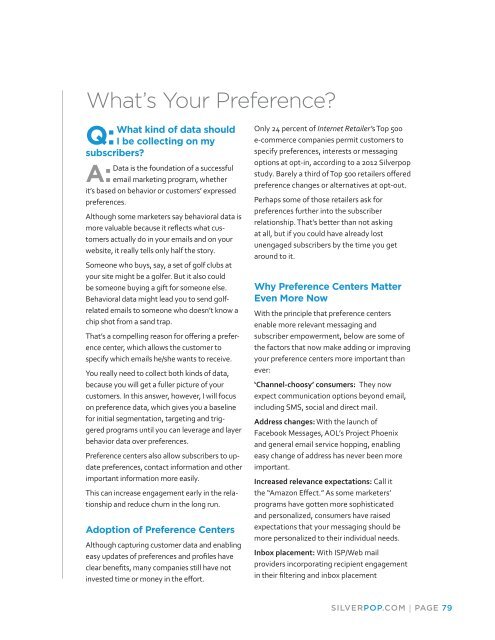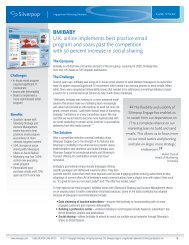eBook - Silverpop
eBook - Silverpop
eBook - Silverpop
You also want an ePaper? Increase the reach of your titles
YUMPU automatically turns print PDFs into web optimized ePapers that Google loves.
What’s Your Preference?<br />
What kind of data should<br />
Q: I be collecting on my<br />
subscribers?<br />
Data is the foundation of a successful<br />
A: email marketing program, whether<br />
it’s based on behavior or customers’ expressed<br />
preferences.<br />
Although some marketers say behavioral data is<br />
more valuable because it reflects what customers<br />
actually do in your emails and on your<br />
website, it really tells only half the story.<br />
Someone who buys, say, a set of golf clubs at<br />
your site might be a golfer. But it also could<br />
be someone buying a gift for someone else.<br />
Behavioral data might lead you to send golfrelated<br />
emails to someone who doesn’t know a<br />
chip shot from a sand trap.<br />
That’s a compelling reason for offering a preference<br />
center, which allows the customer to<br />
specify which emails he/she wants to receive.<br />
You really need to collect both kinds of data,<br />
because you will get a fuller picture of your<br />
customers. In this answer, however, I will focus<br />
on preference data, which gives you a baseline<br />
for initial segmentation, targeting and triggered<br />
programs until you can leverage and layer<br />
behavior data over preferences.<br />
Preference centers also allow subscribers to update<br />
preferences, contact information and other<br />
important information more easily.<br />
This can increase engagement early in the relationship<br />
and reduce churn in the long run.<br />
Adoption of Preference Centers<br />
Although capturing customer data and enabling<br />
easy updates of preferences and profiles have<br />
clear benefits, many companies still have not<br />
invested time or money in the effort.<br />
Only 24 percent of Internet Retailer’s Top 500<br />
e-commerce companies permit customers to<br />
specify preferences, interests or messaging<br />
options at opt-in, according to a 2012 <strong>Silverpop</strong><br />
study. Barely a third of Top 500 retailers offered<br />
preference changes or alternatives at opt-out.<br />
Perhaps some of those retailers ask for<br />
preferences further into the subscriber<br />
relationship. That’s better than not asking<br />
at all, but if you could have already lost<br />
unengaged subscribers by the time you get<br />
around to it.<br />
Why Preference Centers Matter<br />
Even More Now<br />
With the principle that preference centers<br />
enable more relevant messaging and<br />
subscriber empowerment, below are some of<br />
the factors that now make adding or improving<br />
your preference centers more important than<br />
ever:<br />
‘Channel-choosy’ consumers: They now<br />
expect communication options beyond email,<br />
including SMS, social and direct mail.<br />
Address changes: With the launch of<br />
Facebook Messages, AOL’s Project Phoenix<br />
and general email service hopping, enabling<br />
easy change of address has never been more<br />
important.<br />
Increased relevance expectations: Call it<br />
the “Amazon Effect.” As some marketers’<br />
programs have gotten more sophisticated<br />
and personalized, consumers have raised<br />
expectations that your messaging should be<br />
more personalized to their individual needs.<br />
Inbox placement: With ISP/Web mail<br />
providers incorporating recipient engagement<br />
in their filtering and inbox placement<br />
SILVERPOP.COM | PAGE 79







